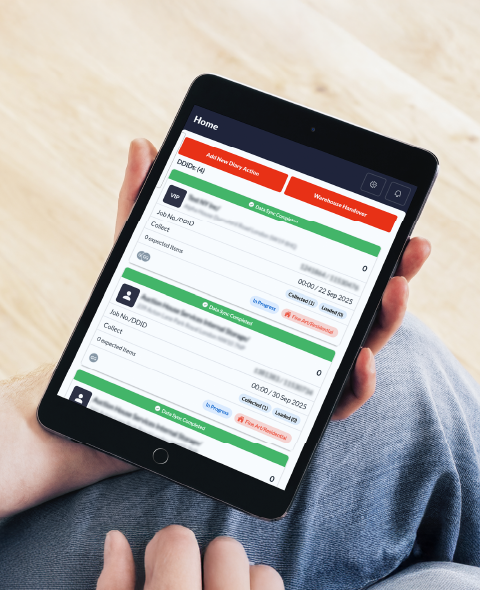AI Logistics Software for Global Moving Crews: Custom AI Mobile App
5×
Faster Item Profiling, Condition Reports40%
Fewer Interruptions in Offline Areas60%
Manual Processes AutomatedCustomer Overview
Our client is a global moving and storage company that manages everything from premium moves involving fine art, antiques, and museum collections to regular home and office relocations. They handle both large-scale and specialized moves across the world, often involving complex cross-country logistics. To improve efficiency, they set out to simplify on-the-ground moving operations in the UK, the US, and Europe.
Project Overview
The client was already using a third-party mobile app to help their on-ground teams with routine moving tasks. However, the app didn’t align with the location-specific workflows that varied based on regional culture and customer expectations. It also restricted usage to a single login per job, so even when a large team was assigned, only one member could access the app at a time. These limitations led to delays, errors, and continued reliance on paperwork. Our client’s goal was to equip on-the-ground teams with technology that reduced manual effort while improving accuracy and efficiency.
Challenges
The client’s old mobile app struggled with workflows, offline use, image quality, reporting, and usability, creating a need for a fully customized in-house solution.
- The old mobile app could not support different workflows for premium high-value moves and regular relocations.
- It allowed only a single login per job, which slowed down large teams working simultaneously across different rooms during packing or unpacking.
- Creating detailed item profiles and condition reports was manual, slow, and prone to errors.
- The old app produced poor-quality images, while the client’s standards required high-resolution photos of every item and box. It also couldn’t process large volumes of images quickly.
- Because it lacked offline functionality for critical features, teams were unable to use the old app reliably in areas with low or no connectivity.
- Job completion reviews still relied on paper forms, as the app’s digital version didn’t fit the teams’ workflow.
- The client wanted the new app to provide comprehensive daily reports covering tasks completed, manpower used, client interactions, and job-wise progress so customers and business stakeholders stayed updated.
- They also needed the new app’s design, features, and integrations to remain fully compatible with their existing third-party SAP system for accurate and timely data management.
Solution
Developed an AI-powered Android app with core and advanced features to support different workflows, enable offline use, and automate processes for efficient on-ground moving operations.
- Built an Android app for on-ground teams across different geographies to support their location-specific workflows for both premium high-value moves and regular relocations.
- Enabled role-based access to allow multiple crew members to log in to the same job simultaneously, while supervisors can monitor and approve tasks.
- Automated item profiling and condition reporting using Gen AI. Crew members capture images in the app, Claude 3.5 LLM processes them to generate item titles, descriptions & tags for profiling and condition reports, which are then verified and, if needed, edited by the crew before submission, ensuring accuracy.
- Integrated high-end camera capabilities for capturing high-resolution images and optimized backend processing to resize and handle hundreds of images within minutes.
- Enabled uninterrupted use in low or no-connectivity areas by implementing Realm for offline sync along with auto-save and offline-ready features.
- Utilized QR codes and barcodes with nesting and linking logic to connect items with their boxes and vehicles.
- Customized digital job completion forms to match different workflows and added manager notifications for job completion and feedback reporting.
- Developed tailored reporting to provide both job-specific insights and daily summaries of tasks completed by the on-ground team.
- Devised custom integration solutions using APIs to ensure seamless compatibility with the client’s old, third-party SAP system, enabling accurate and timely data management.
Benefits
The AI logistics software or the AI-powered mobile app we developed for our client’s on-ground moving teams offered the following advantages:
- 80% reduction in item profiling and condition reporting creation time. 60% of manual processes automated, resulting in a 35% increase in efficiency.
- Enabled offline access in low/no connectivity areas, reducing workflow interruptions by 40% and keeping tasks on track.
- Enabled high-resolution image capture and processing of hundreds of photos in minutes, supporting image-driven workflows.
- Digitized job-level and daily summaries improved reporting efficiency by 65%, giving managers timely visibility into ground operations.
Technology
- Flutter
- Realm
- OpenAI
- Claude 3.5
- MongoDB
- Firebase Analytics
Industry
- Logistics

Conclusion
TenUp built a custom AI-powered mobile app tailored to job type and location-specific workflows, transforming the client’s on-ground moving operations. Automated item profiling and condition reporting, high-resolution image capture, offline functionality, and real-time reporting reduced manual effort, minimized errors, and boosted efficiency. Managers gained timely insights, and the app maintained seamless integration with the existing SAP system. Overall, it enabled the client to scale global operations while ensuring accuracy and consistency across every move.
Frequently asked questions
What makes AI logistics software different from traditional moving apps?
AI logistics software automates workflows, supports multiple users, and provides real-time tracking, predictive planning, and intelligent reporting. Unlike traditional apps that rely on manual processes and single-logins, AI solutions optimize moves dynamically, reduce errors, and improve efficiency for both crews and customers.
How can AI improve item profiling and condition reporting for movers?
AI uses computer vision and machine learning to automatically identify, tag, and assess items, generating detailed inventories and detecting damage in real time. This automation reduces reporting time by up to 80%, minimizes human error, and creates transparent, verifiable records that prevent disputes and improve customer trust.
Why is offline functionality critical for moving crews in global operations?
Offline functionality lets moving crews stay productive even in low-connectivity areas. AI logistics software enables task updates, photo capture, and reporting without internet access, ensuring uninterrupted workflows, accurate data, and faster job completion across regions.
How does AI logistics software integrate with existing ERP or SAP systems?
AI logistics software connects with ERP or SAP systems through secure APIs, enabling real-time data sync for reporting, inventory tracking, and compliance. This integration enhances visibility and automation without replacing existing infrastructure, ensuring smoother, data-driven logistics operations.
What role does high-resolution image capture play in AI-powered moving apps?
High-resolution image capture enables AI to precisely identify items, assess conditions, and detect damage with greater accuracy. It enhances documentation quality, reduces disputes, and supports reliable, automated reporting throughout the moving process.
What are the measurable benefits of implementing AI logistics software?
AI logistics software delivers up to 20% lower costs, 35% higher efficiency, and 5× faster reporting by automating workflows and improving real-time visibility—resulting in fewer delays and reduced manual effort.
What emerging AI technologies are transforming mobile logistics applications?
Generative AI, LLMs like Claude 3.5, computer vision, and predictive analytics empower logistics apps to automate workflows, analyze images for item profiling, and provide actionable insights—boosting efficiency and reducing errors.


